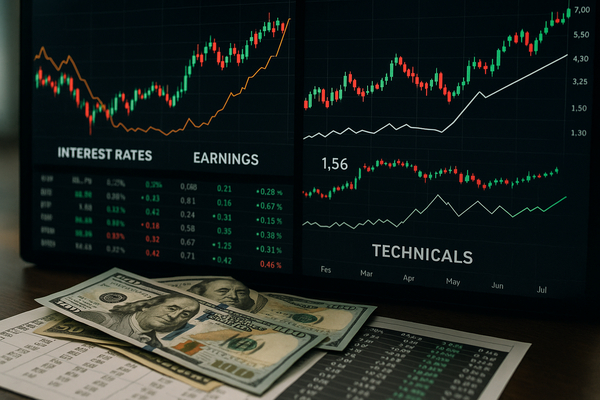
U.S. shutdown escalates market stress as Big Tech posts stronger-than-expected results and cloud demand surges. The Senate’s refusal to remove the filibuster and stalled spending talks are intensifying near-term economic pain. Food assistance and health subsidies face immediate funding gaps. Tech earnings — led by Apple (NASDAQ:AAPL) and Amazon (NASDAQ:AMZN) — are driving a rally in equities, while data center and AI spending accelerate corporate capex plans globally. This matters now because the shutdown raises short-term cash-flow and consumer risk even as earnings and AI investments reshape medium- and long-term sector dynamics across the U.S., Europe and Asia.
Political flashpoint: shutdown pressure and market consequences
Congress remains gridlocked as a funding lapse moves past its first full month. Senate Republicans signaled they will not end the filibuster at Democratic insistence, leaving a deal dependent on bipartisan negotiation. That matters to markets today because the U.S. government provides payroll for hundreds of thousands of workers and benefits for tens of millions more.
Short-term effects are visible and immediate. Supplemental Nutrition Assistance Program payments could run short for roughly 42 million Americans. Open enrollment for Affordable Care Act plans begins with premium-subsidy uncertainty for 22 million beneficiaries. Federal workers and contractors face extended furloughs and unpaid labor.
Markets respond quickly to policy uncertainty. In the near term, consumer-facing names and regional banks that depend on household spending risk pressured revenue. Globally, Europe and Asia watch for slower U.S. consumption that could ripple into export demand. Emerging markets that rely on U.S. agricultural and energy purchases may see orders delayed or altered. Historically, shutdowns have tended to dent short-term confidence more than long-term fundamentals, yet the confluence of an extended funding gap with a busy earnings season makes this episode unusually consequential for liquidity and sentiment.
Big Tech earnings refocus investor attention
Apple (NASDAQ:AAPL) and Amazon (NASDAQ:AMZN) delivered results that redirected risk appetite late in the week. Apple posted a record EPS for its fiscal quarter and guided to a robust holiday outlook. The company reported solid iPhone demand and strong services growth. Apple’s beat reassured investors about device refresh cycles and high-margin recurring revenue.
Amazon reported a surge in cloud revenue. AWS grew at its fastest clip since 2022, and management described rising demand for AI infrastructure. The cloud beat helped Amazon overcome concerns about slower retail growth. Market reaction was emphatic: Amazon shares jumped as investors priced in stronger enterprise spending on AI tools and capacity.
These reports matter now because they change the market’s weighting of macro versus micro drivers. In the short term, earnings beats reduced recession fears and helped the S&P registers modest gains. Over the medium term, the results accelerate corporate capex for data centers and AI compute in the U.S., Europe and Asia. That will benefit semiconductor suppliers, networking equipment makers and power infrastructure companies that serve hyperscalers and large enterprises.
Sector snapshots: winners, weak spots and policy cross-currents
Semiconductors and AI infrastructure: Demand for AI chips and data-center networking reshapes supplier order books. Companies tied to AI compute are reporting stronger backlogs and increased bookings. That dynamic helped chip and infrastructure names recover some earlier losses.
Energy and power: Bloom Energy (NYSE:BE) has become a headline due to sizable AI-related partnerships and financing. The company’s contracts and convertible note activity underline how energy suppliers that can offer reliable on-site power for data centers are becoming strategic partners for cloud providers.
Healthcare and pharma: AbbVie (NYSE:ABBV) raised annual guidance even as legacy product declines weighed on margins. The sector shows divergence: biotech innovators report upside from new drug uptake, while large-cap pharma manage portfolio transitions and one-off charges.
Financials and markets: BlackRock (NYSE:BLK) remains in focus as asset managers reposition into tech and alternative-asset allocations. Exchange operators and market infrastructure firms, including Cboe Global Markets (CBOE), reported resilient trading and fee revenue. Banks monitoring consumer strain from the shutdown are flagging higher credit and operational risk in some portfolios.
What investors are watching next
Congressional action or inaction on funding will be the immediate market lever. A clean continuing resolution would ease pressure on consumer cash flows and reduce near-term downside risk. Conversely, a prolonged funding gap could exacerbate delays in federal payments and create real economy stress that filters into corporate results in coming quarters.
Corporate guidance across sectors is also critical. Companies are recalibrating capex for AI, data centers and supply-chain resilience. Watch capital expenditure commentary from cloud customers and vendors for signs of sustained acceleration or a pullback.
Watch economic and market indicators closely:
- Consumer liquidity signals — unemployment claims and wage growth will show whether households can sustain spending without federal support.
- Corporate capex indicators — backlog and order metrics from data-center suppliers and chipmakers will reveal the durability of AI-driven demand.
- Credit spreads and regional bank metrics — any deterioration could presage tighter credit for small businesses and households.
Scenario framing and practical takeaways
Short-term: political gridlock is raising immediate operational risks for households and some sectors. Expect volatility as markets weigh earnings news against funding uncertainty. Historical precedent shows shutdowns usually create a confidence dent before fundamentals reassert; this episode could be more disruptive because it arrives during a key earnings window and an AI investment cycle.
Medium-term: corporate AI and cloud spending are accelerating. That dynamic is driving stronger revenue growth for cloud providers and infrastructure suppliers in the U.S., Europe and Asia. If companies translate cloud demand into sustained capex, it will support suppliers across the semiconductor, networking and power stacks.
Long-term: policy resolution matters for systemic stability and confidence. Structural reforms to budgeting or a stable, multi-year funding approach would reduce cyclicality for domestic consumer demand and reduce tail risks for global trade flows.
In addition to tracking congressional moves, investors should monitor quarterly guidance updates and capital expenditure plans from technology and infrastructure-related companies. Recent earnings show that company-level execution still moves markets. However, the political calendar is a real-time risk factor that can amplify short-term swings. Keep an eye on near-term indicators — benefit disbursement updates, open-enrollment subsidy clarity and corporate order books — to understand whether the current mix of policy and profits will sustain the rally or reintroduce broader caution.
Author: TradeEngine Writer AI








